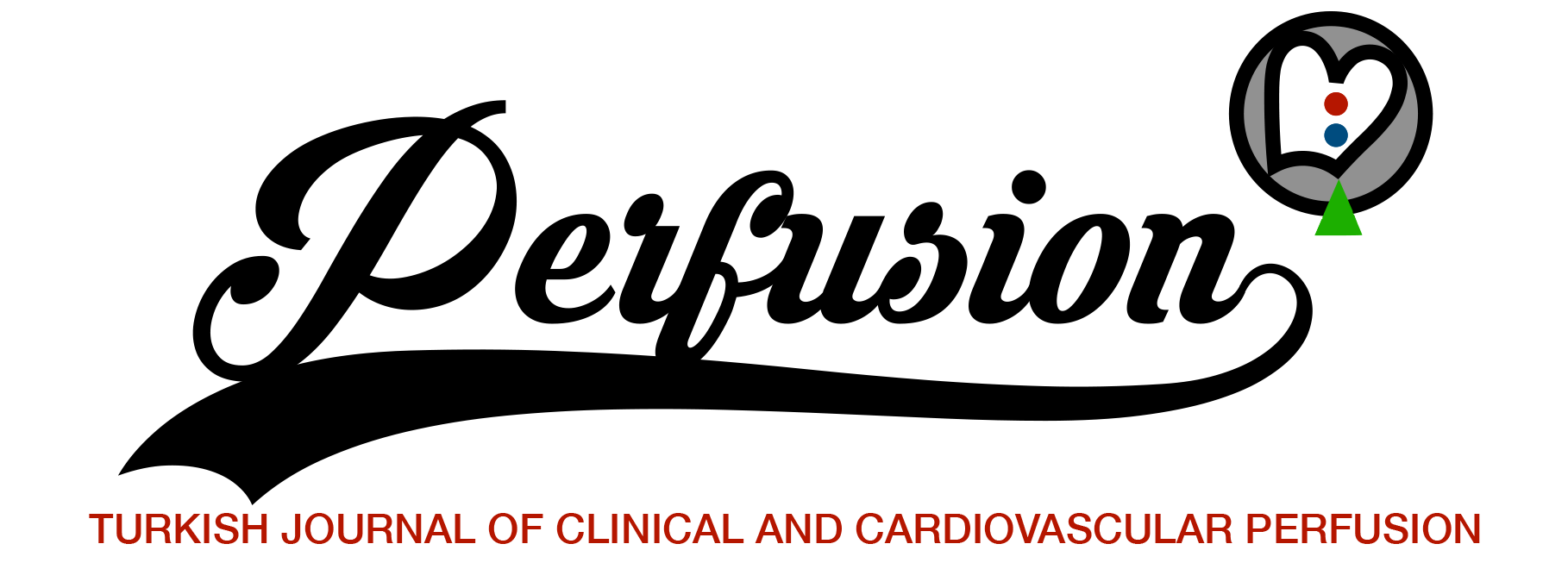ABSTRACT
Objective:
During cardiopulmonary bypass (CPB) and in the postoperative period, high lactatemia is a common condition. Lactate increases in anaerobic energy metabolism because of low tissue oxygenation or disturbances in tissue circulation. The aim of this study was to investigate the effects of CPB hypothermia and normothermia on lactate and pH levels.
Materials and Methods:
The patients were divided into hypothermic group 1 (n=35) and normothermic group 2 (n=35) during CPB. The two groups were compared in terms of preoperative, peroperative, and postoperative biochemical values, ejection fraction changes, inotrope use and dose, intensive care unit length of stay, and extubation times.
Results:
There was no statistically significant difference between the groups in terms of pre-CPB, post-CPB and postoperative 24th hour pH values (p>0.05). There was a statistically significant difference in postoperative pH values between the groups (Z=-2.391; p=0.017). There was no statistically significant difference between the groups in terms of pre-CPB and post-CPB lactate values (p>0.05). There was a statistically significant difference between the groups in terms of 24 h lactate values (Z=-1.962; p=0.049).
Conclusion:
The results suggest that maintaining normothermia may favorably affect postoperative lactate and pH levels.
Keywords:
Hypothermia, cardiopulmonary bypass, normothermia, serum lactate
References
1Hessel EA, Edmunds LH. Hessel EA II, Edmunds LH Jr. Extracorporeal Circulation: Perfusion Systems. Cardiac Surgery in the Adult New York: McGraw-Hill 2003:317338.
2Baue AA. Cardiopulmonary bypass for open heart surgery. Glenn’s thoracic and cardiovascular surgery. Prentice-Hall International Inc 1396, 1991.
3Raper RF, Cameron G, Walker D, Bowey CJ. Type B lactic acidosis following cardiopulmonary bypass. Crit Care Med 1997;25(1):46-51.
4Boldt J, Piper S, Murray P, Lehmann A. Case 2-1999. Severe lactic acidosis after cardiac surgery: sign of perfusion deficits? J Cardiothorac Vasc Anesth 1999;13(2):220-224.
5Stedman‘s medical dictionary. In: Spraycar M (ed). 26th ed. Baltimore, Williams & Wilkins, 1995:869.
6Carola R, Harley JP, Noback CR. The Cardiovascular System Blood Human Anatomy Physiology.
7Ross MH, Romrell LJ, Kaye GI. Histology A Text And Atlas 0-683-07369-9 Library of Congress Cataloging-in-Publication Data, 1995.
8Ranucci M, Romitti F, Isgrò G, Cotza M, Brozzi S, Boncilli A, et al. Oxygen delivery during cardiopulmonary bypass and acute renal failure after coronary operations. Ann Thorac Surg 2005;80(6):2213-2220.
9Demers P, Elkouri S, Martineau R, Couturier A, Cartier R. Outcome with high blood lactate levels during cardiopulmonary bypass in adult cardiac operation. Ann Thorac Surg 2000;70(6):2082-2086.
10Bakker J, Coffernils M, Leon M, Gris P, Vincent JL. Blood lactate levels are superior to oxygen-derived variables in predicting outcome in human septic shock. Chest 1991;99(4):956-962.
11Stover EP, Siegel LC, Hood PA, O’Riordan GE, McKenna TR. Platelet-rich plasma sequestration, with therapeutic platelet yields, reduces allogeneic transfusion in complex cardiac surgery. Anesth Analg 2000;90(3):509-516.



